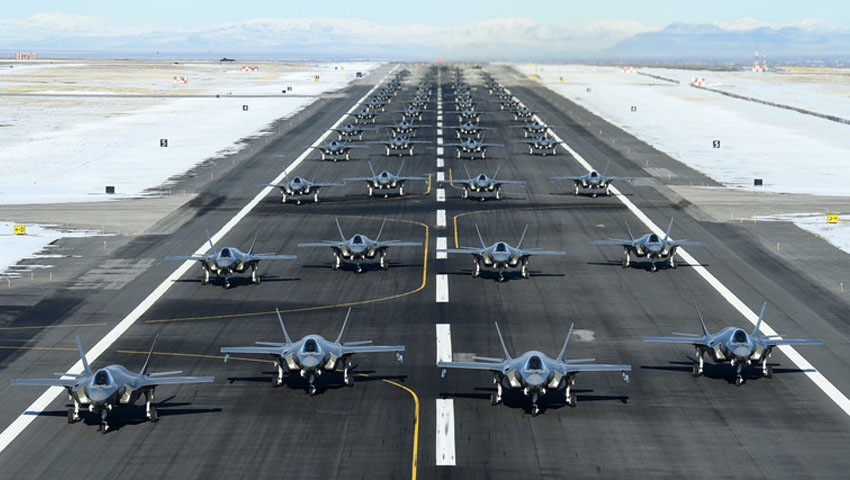Following a revelatory report by the Pentagon’s Robert Behler, Director of Operational Test and Evaluation (DOT&E), that revealed hundreds of “unresolved deficiences” with the F-35, Lockheed Martin has responded.
For reference, the Director, Operational Test and Evaluation: FY2019 Annual Report conducted by Behler, Director of Operational Test and Evaluation (DOT&E), revealed "873 unresolved deficiencies" with multibillion-dollar platform.
Behler's report into the F-35 program stated, "Although the program is working to fix deficiencies, new discoveries are still being made, resulting in only a minor decrease in the overall number of deficiencies.
"There are many significant deficiencies that should be addressed to ensure the System Development and Demonstration (SDD) baseline configuration is stable prior to introducing the large number of new capabilities planned in Block 4."
Most startling of which is the revelation that airframes of the Lot 9 build and subsequent lot builds have experienced cracks in the outer mold-line coatings and the underlying chine longeron skin, located near the 25mm gun muzzle of the F-35A variant.
In response, a Lockheed Martin spokesperson told Defence Connect, "The F-35 continues to mature and is the most lethal, survivable and connected fighter in the world. The warfighter identifies the F-35 capabilities as game changing, transforming the way our men and women in uniform conduct operations.
"Last year, Lockheed Martin delivered 134 aircraft, exceeding our commitment of 131, while continuing to drive down unit costs and cost per flying hour. Reliability continues to improve, with the global fleet averaging greater than 65 per cent mission capable rates and operational units consistently performing near 75 per cent. Soon we will deliver our 500th aircraft, train the 1,000th F-35 pilot and surpass 250,000 flight hours."
Regarding concerns about the continued use of the F-35A variant's main 25mm gun impacting the low observable skins of the F-35A and issues relating to the accuracy of the weapon system, the Lockheed Martin spokesperson explained:
"The F-35 enterprise has made significant progress regarding the F-35 gun since the data used for the DOT&E report. In the F-35A integral gun, we have implemented software updates and installed a field gun alignment aid to ensure proper gun barrel position. We tested this in December and the results were improved accuracy."
The Lockheed Martin spokesperson added, "It should be noted that the B and C models carry a LO belly gun pod mounted on centerline and had no barrel alignment issues. As for the software on all variants, conversion conditions and algorithms were reviewed. Updated conversions have been implemented in the software and the corrected software has been delivered to the field.
"It remains the warfighter’s choice when to update to the newest software. This software provides improved precision, further highlighting the value of agile software implementation. We knew the complexity of incorporating a gun on a high performance aircraft would be a challenge, but we are confident in the steps we’ve taken and the progress we’ve made."
The Lockheed Martin F-35 Joint Strike Fighter is billed as a catalyst for the fifth-generation revolution, changing the face and capability of the Royal Australian Air Force and the wider Australian Defence Force.
For the RAAF, the F-35A's combination of full-spectrum low-observable stealth coatings and materials, advanced radar-dispersing shaping, network-centric sensor and communications suites – combined with a lethal strike capability – means the aircraft will be the ultimate force multiplying, air-combat platform.
The F-35A – the variant chosen by the RAAF – will have a projected life of 30 years in service. Ten nations are currently flying F-35s, including the US, UK, Italy, Norway, Israel and Japan.
The first of Australia’s F-35A aircraft are now based on home soil after a period of training and development at Luke Air Force Base in Arizona, US, plus an epic Pacific Ocean crossing in December 2018.
More than 340 F-35s are operating today with partner nations, more than 700 pilots and 6,500 maintainers have been trained, and the F-35 fleet has surpassed more than 170,000 cumulative flight hours.
Over the coming years, Australia will purchase 72 of the advanced fifth-generation fighter aircraft as part of the $17 billion AIR 6000 Phase 2A/B program – which is aimed at replacing the ageing F/A-18A/B Classic Hornets that have been in service with the RAAF since 1985.
The full report into the F-35 program is available here.








